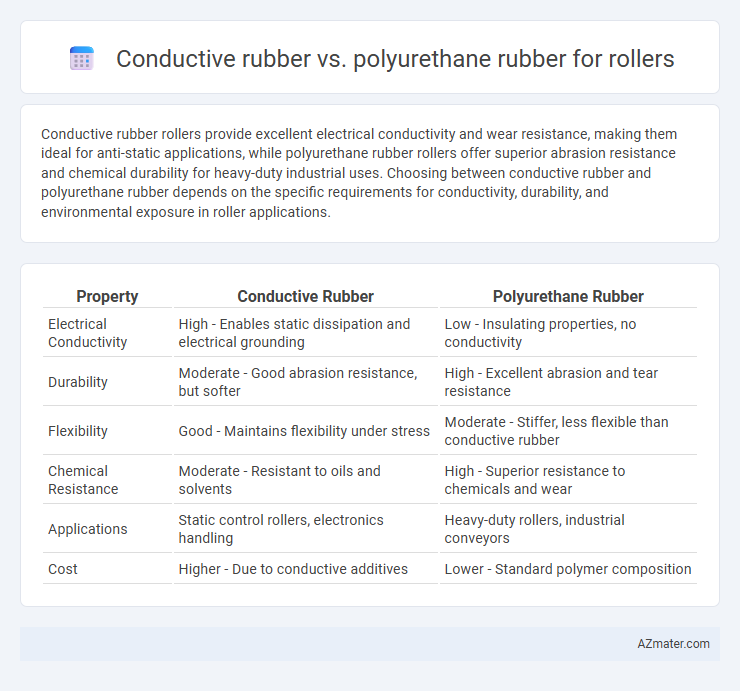Conductive rubber rollers provide excellent electrical conductivity and wear resistance, making them ideal for anti-static applications, while polyurethane rubber rollers offer superior abrasion resistance and chemical durability for heavy-duty industrial uses. Choosing between conductive rubber and polyurethane rubber depends on the specific requirements for conductivity, durability, and environmental exposure in roller applications.
Table of Comparison
| Property | Conductive Rubber | Polyurethane Rubber |
|---|---|---|
| Electrical Conductivity | High - Enables static dissipation and electrical grounding | Low - Insulating properties, no conductivity |
| Durability | Moderate - Good abrasion resistance, but softer | High - Excellent abrasion and tear resistance |
| Flexibility | Good - Maintains flexibility under stress | Moderate - Stiffer, less flexible than conductive rubber |
| Chemical Resistance | Moderate - Resistant to oils and solvents | High - Superior resistance to chemicals and wear |
| Applications | Static control rollers, electronics handling | Heavy-duty rollers, industrial conveyors |
| Cost | Higher - Due to conductive additives | Lower - Standard polymer composition |
Introduction: Overview of Roller Materials
Conductive rubber and polyurethane rubber are two widely used materials for rollers, each offering distinct properties tailored to specific industrial applications. Conductive rubber provides excellent electrical conductivity and static dissipation, making it ideal for environments requiring electrostatic discharge control. Polyurethane rubber excels in durability, abrasion resistance, and load-bearing capacity, ensuring long service life in heavy-duty roller applications.
What is Conductive Rubber?
Conductive rubber is a specialized elastomer embedded with conductive materials like carbon black or metal particles, enabling it to dissipate static electricity and prevent electrical buildup. This type of rubber is commonly used in rollers for applications requiring anti-static properties, such as electronics manufacturing and printing industries. In contrast, polyurethane rubber offers superior abrasion resistance and mechanical strength but lacks intrinsic conductivity, making conductive rubber the preferred choice for rollers demanding electrostatic discharge control.
What is Polyurethane Rubber?
Polyurethane rubber is a versatile elastomer known for its high durability, abrasion resistance, and impressive load-bearing capacity, making it ideal for rollers in heavy-duty industrial applications. It offers superior chemical resistance and elasticity compared to conductive rubber, which is primarily used for its electrical conductivity properties. Polyurethane rubber's enhanced wear resistance and mechanical strength ensure longer service life and reliable performance in conveyor systems and material handling equipment.
Key Properties Comparison
Conductive rubber rollers exhibit excellent electrical conductivity, making them ideal for applications requiring static dissipation and electrostatic discharge control, whereas polyurethane rubber rollers provide superior abrasion resistance, high tensile strength, and outstanding durability under mechanical stress. Conductive rubber typically features lower hardness and flexibility tailored for precise surface contact, while polyurethane rubber offers enhanced chemical resistance and load-bearing capacity suitable for heavy-duty roller functions. The choice between conductive and polyurethane rubber rollers hinges on balancing electrical performance with mechanical durability for specific industrial uses.
Electrical Conductivity Differences
Conductive rubber rollers exhibit significantly lower electrical resistance, typically ranging from 10^3 to 10^6 ohm-cm, enabling efficient static dissipation and protection in electronic applications. Polyurethane rubber rollers generally have much higher resistivity, often exceeding 10^12 ohm-cm, resulting in poor electrical conductivity and limited use in static-sensitive environments. The intrinsic filler materials, such as carbon black or metal particles in conductive rubber, create conductive pathways absent in standard polyurethane compounds, highlighting their critical difference for electrostatic discharge control.
Durability and Wear Resistance
Conductive rubber rollers exhibit superior durability and wear resistance due to their enhanced electrical conductivity and resilience under friction, making them ideal for applications requiring static dissipation and extended service life. Polyurethane rubber rollers, renowned for their exceptional abrasion resistance and toughness, offer excellent wear resistance but may lack the conductivity properties of conductive rubber. Selecting between conductive rubber and polyurethane depends on prioritizing electrical conductivity alongside durability or focusing primarily on mechanical wear resistance and toughness.
Chemical and Environmental Resistance
Conductive rubber rollers offer excellent chemical resistance against solvents, oils, and acids, making them suitable for environments exposed to harsh chemicals, while polyurethane rubber rollers provide superior environmental resistance with robust performance against abrasion, ozone, and UV exposure. Polyurethane rubber maintains elasticity and strength in extreme temperature variations and resists deformation under mechanical stress better than conductive rubber. Choosing between conductive and polyurethane rubber rollers depends on specific application requirements related to chemical exposure and environmental durability.
Cost and Availability
Conductive rubber rollers generally have higher material costs due to specialized fillers like carbon or metal particles that enhance electrical conductivity, while polyurethane rubber rollers are more cost-effective with widespread availability in various grades and durometers. Polyurethane rubber offers extensive supply from multiple manufacturers, enabling easier procurement and lower lead times compared to conductive rubber, which is less common and typically requires custom production. Cost efficiency and availability make polyurethane rubber the preferred choice for high-volume roller applications, whereas conductive rubber is selected for niche uses requiring static dissipation or conductivity.
Best Applications for Each Rubber Type
Conductive rubber rollers excel in applications requiring static dissipation and electrical conductivity, such as in electronics manufacturing and printing industries, where preventing static buildup is critical. Polyurethane rubber rollers offer superior abrasion resistance, load-bearing capacity, and chemical resistance, making them ideal for heavy-duty conveyor systems, material handling, and industrial rollers exposed to harsh environments. Selecting between conductive rubber and polyurethane rollers depends on whether the priority is electrical conductivity or enhanced durability under mechanical stress.
Conclusion: Choosing the Right Rubber for Rollers
Conductive rubber offers excellent electrical conductivity, making it ideal for applications requiring static dissipation and electronic component protection in rollers. Polyurethane rubber provides superior abrasion resistance and load-bearing capacity, enhancing roller durability in heavy-duty industrial environments. Selecting the right rubber depends on prioritizing either electrical conductivity for anti-static functions or mechanical resilience for extended wear and performance.

Infographic: Conductive rubber vs Polyurethane rubber for Roller
 azmater.com
azmater.com